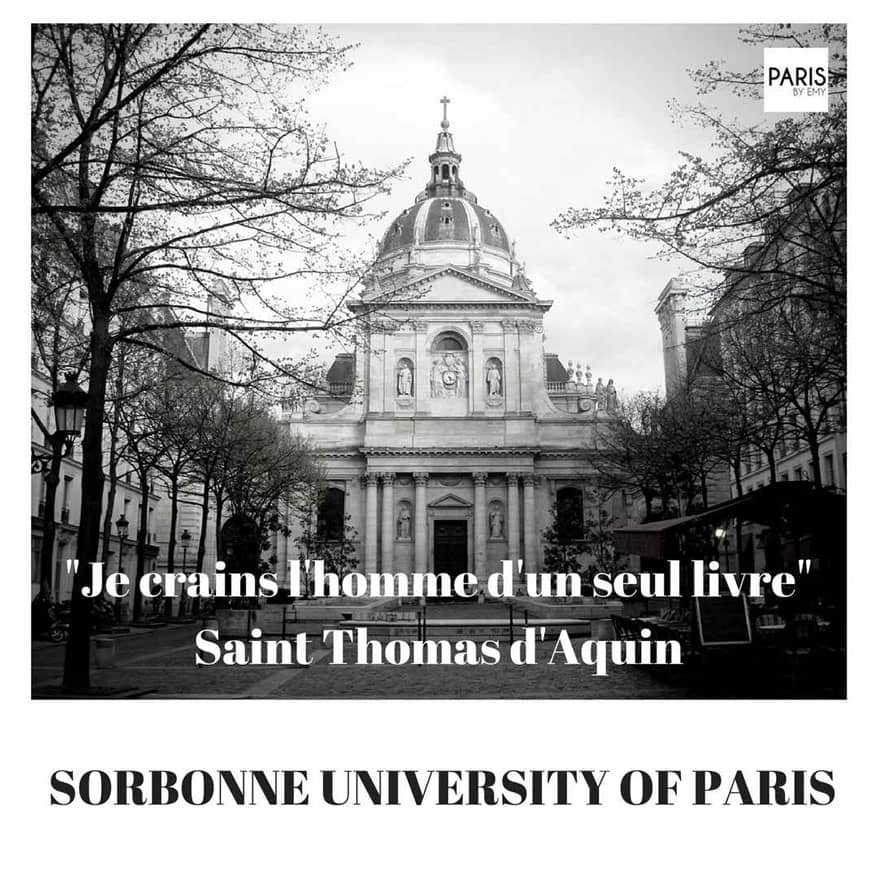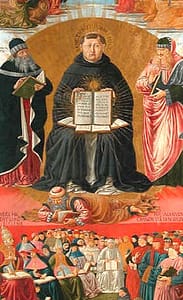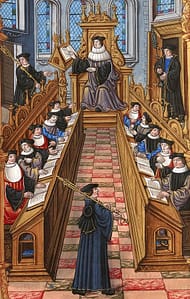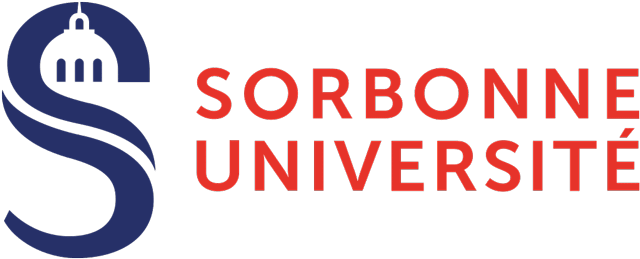|University of Paris|
The Sorbonne University sounds worldwide famous thanks to its cultural background, knowledge and wisdom. Located in the heart of the Latin Quarter, the Sorbonne was founded 8 centuries ago by Robert de Sorbon.
Below the Sorbonne Chapel, a Roman Catholic chapel located on the Sorbonne historical site, with a quote of Saint Thomas d’Aquin “I fear the man of only one book” and a statue of Saint Thomas, left side of the clock.
Hic et ubique terrarum (Latin, Here and anywhere on Earth)
The Sorbonne University and history
The Sorbonne University is one of the oldest universities in the world.
The Sorbonne owes its name to its founder, Robert de Sorbon, Chaplain and confessor of King of France Saint-Louis (Louis IX). Emerging around 1150 as a corporation associated with the cathedral school of Notre Dame de Paris, the University is born in the XIIIth century. Primitively settled on the Island of the City, the latter came, from the XIIth century, in the future “Latin Quarter”, left bank of the Seine, where the theology, the law, the medicine and the arts were taught, outdoor, young people coming from 4 Nations, so conferring to the University, from the start, an international prestige.
One of the first French major strike started at the Sorbonne University in 1229. It was a masters’ and teachers’ strike associated with students in a fight against the Bishop of Paris and the Queen of France. It resulted in the university being paralyzed for 2 years. Teachers and students were united in protest against the deadly repression of a students riot by the civil authorities, according to which the students were dependent on ecclesiastical justice. This riot had taken place during altercations on Mardi Gras. On April 13, 1231, after 2 years of negotiation, Pope Gregory IX addressed the professors and students of the University of Paris the papal bull Parens scientiarum. Through it, he granted the main privileges of its intellectual and legal independence
In 1793, during the French Revolution, the university was closed and by Item-27 of the Revolutionary Convention, the college endowments and buildings were sold. A new University of France replaced it in 1806 with four independent faculties: the Faculty of Humanities (French: Faculté des Lettres), the Faculty of Law (later including Economics), the Faculty of Science, the Faculty of Medicine and the Faculty of Theology.
MAY 1968 (mai 68) : The biggest general strike, starting at the Sorbonne students protests against capitalism, consumerism, American imperialism, traditional institutions, values and order. 11 million workers, more than 22% of the total population of France at the time, for two continuous weeks were involved in Mai 68. It brought the entire economy of France to a virtual halt.
In 1970, following the May 1968 events, the university was divided into 13 autonomous universities. Although all the thirteen universities that resulted of the original University of Paris split can be considered its inheritors, just three universities of the post-1968 universities embodied direct faculties successors while inheriting the name “Sorbonne”, as well as its physical location in the Latin Quarter: the Pantheon-Sorbonne University (Paris I; law); University of Paris III: Sorbonne Nouvelle; and Paris-Sorbonne University (Paris IV; humanities).
Saint Thomas d’Aquin one of its teachers
In 1245, Saint Thomas d’Aquin left Italy, clerical and aristocratic privileges to study & teach at the Sorbonne. At that time, Kings, Popes would go to study at the University of Paris for its new ideas, visionary leadership and Excellence.
He was an immensely influential philosopher, theologian, and jurist in the tradition of scholasticism, within which he is also known as the Doctor Angelicus and the Doctor Communis. He was the foremost classical proponent of natural theology and the father of Thomism.
Saint Thomas d’Aquin argued that reason is found in God
His influence on Western thought is considerable, and much of modern philosophy developed or opposed his ideas, particularly in the areas of ethics, natural law, metaphysics, and political theory. Thomas embraced several ideas put forward by Aristotle—whom he called “the Philosopher”—and attempted to synthesize Aristotelian philosophy with the principles of Christianity. Below, Saint Thomas d’Aquin.
The Catholic Church honors Thomas Aquinas as a saint and regards him as the model teacher for those studying for the priesthood, and indeed the highest expression of both natural reason and speculative theology. In modern times, under papal directives, the study of his works was long used as a core of the required program of study for those seeking ordination as priests or deacons, as well as for those in religious formation and for other students of the sacred disciplines (philosophy, Catholic theology, church history, liturgy, and canon law). Below, A meeting of doctors at the university of Paris. From the “Chants royaux” manuscript, BNF, Paris.
The Sorbonne University nowadays
Today, the Sorbonne University is a public research university, established by the merger in 2018 of Paris-Sorbonne University, Pierre et Marie Curie University, and other institutions.
50,000 students in 14 teaching and research departments,
8,000 of whom are from outside France
3 Faculties at the Sorbonne University
The Sorbonne University has 3 faculties; additionally, Law is taught by Panthéon-Assas University.
- Arts & Humanities
Letters are the more ancient teachings of the Sorbonne University. Classical and Modern Letters, Archeology, Art History, Languages, Linguistics, Literature, Social Sciences such as Sociology, History, Geography, Musicology, Philosophy, Sciences of Information and Communication and the Science of Education are part of this faculty.
- Science
The Faculty of Science of Sorbonne University is a major research institution in France. It can be considered the successor in direct line to the Faculty of Science of the University of Paris. It has more than 125 laboratories, in association with the Centre national de la recherche scientifique (CNRS). Some of its most notable institutes and laboratories include the Institut Henri Poincaré (Mathematics), Institut d’astrophysique de Paris (Astrophysics), LIP6 (Informatics / Computer Science), Institut de mathématiques de Jussieu (foundations of Mathematics, shared with University Paris-Diderot) and the Laboratoire Kastler-Brossel (Quantum Physics, shared with École Normale Supérieure).
- Medicine
The faculty of Medicine is located in the teaching hospitals Pitié-Salpêtrière and Saint-Antoine (the latter itself being the successor to Saint-Antoine-des-Champs Abbey).
Alliance Sorbonne Université
The Sorbonne Universities Association was renamed to Alliance Sorbonne Université and groups the following institutions for academic cooperation such as the National Museum of Natural History established in 1635, the Centre National de la Recherche Scientifique CNRS, the Pôle supérieur d’enseignement artistique of Paris Boulogne-Billancourt PSPBB, the Business School of the world INSEAD, …
- Its ten members have a shared vision favouring a global approach to education and research, combining the fields of the Arts, Humanities, Medicine, Science, Engineering, Technology, and Management.
- The diversity of the members of the Sorbonne University Alliance favours encourages a global approach to education and research.
- It promotes equal access to knowledge and develops numerous shared programmes and projects in degree programmes, continuous and lifelong education in all disciplines, in research and innovation, and in the diffusion of their findings.
The university is nowadays the seat of the Academy Rectorate, of the Chancellery of Paris Universities, and hosts several departments of higher education and research centers internationally well-known.
Enjoy a genuine personalized tour according to your profile, from couple, family to school trips.
Emy,







